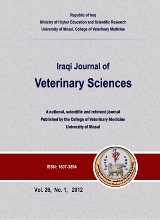Abstract
Sodium benzoate SB is a white powder, used as preservative and food additive. Biochemical, physiological and histopathological effects of SB been tested in adult male rats. Twenty-four adult albino male rats aged100 day and weighted 250-350 g were used. Animals were divided into 4 groups. The first group considered as control, which received normal saline orally, other groups treated with SB by 300, 400, 500 mg/Kg of body weight respectively for 30 days. At the end of experiment, blood samples were collected from retro orbital sinus. Heart, liver, spleen, kidneys and brain were obtained for weight recording. The results indicated a significant decrease of super oxide dismutase SOD activity and a significant increase of nitric oxide NO level of treated group 500 mg/Kg of body weight. Moreover, findings revealed that there are no significant changes in growth hormone GH activity and body weight. A significant reduction of heart weight of treated group 500 mg/Kg of body weight were observed. The histopathological changes ranged from mild to severe in the brain cortex, as focal gliosis, satellitosis, mild vacculation and vasogenic edema in treated groups with SB by different doses. Also, some changes were observed in liver represented by congestion of portal vein, mild hydropic degeneration of hepatocytes, stenosis of sinusoids, steatosis and necrosis of hepatocytes in treated groups with SB compared to control group. It concluded that short-term exposure to high doses of SB may be considered an oxidant substance that caused oxidative stress. Furthermore, SB can harm various organs in the body.
Keywords
growth hormone
nitric oxide
sodium benzoate
Abstract
تستخدم بنزوات الصوديوم بصورة واسعة كمادة حافظة ومضاف غذائي للكثير من الاطعمة ويعتقد ان التعرض لفترة طويلة لهذه المادة وزيادة تراكيزها في الدم يؤدي الى تأثيرات جانبية على صحة الانسان واعضاءه الحيوية. تضمن البحث امكانية اختبار التأثيرات الكيموحيوية والفسلجية والنسيجية لبنزوات الصوديوم في ذكور الجرذان البالغة, حيث تم استخدام 24 منها تتراوح اوزانها بين 250-350 غم, تم تقسيمها الى 4 مجاميع. اعتبرت المجموعة الاولى مجموعة سيطرة تلقت المحلول الملحي عن طريق الفم في حين اخضعت المجاميع الثلاثة الاخرى للمعاملة ببنزوات الصوديوم بالجرع 300, 400, 500 ملغم / كغم على التوالي لمدة 30 يوما, ثم جمعت عينات الدم من محجر العين لتقديراوكسيد النتريك وفعالية انزيم فوق اوكسيد الدسميوتيز ونشاط ةهرمون النمو في مصل الدم. اظهرت النتائج وجود زيادة معنوية في تركيز اوكسيد النتريك وانخفاض معنوي في فعالية انزيم فوق اوكسيد الدسميوتيز في مصل الدم للمجموعة المعاملة بالجرعة 500 ملغم / كغم مقارنة بمجموعة السيطرة, بينما لم تظهر النتائج وجود فرق معنوي في فعالية هرمون النمو ووزن الجسم. كذلك اشارت النتائج الى وجود انخفاض معنوي مقارنة بمجموعة السيطرة في وزن القلب للمجموعة المعاملة ببنزوات الصوديوم بالجرعة 500 ملغم / كغم. علاوة على ذلك, اظهر الفحص النسجي تغيرات تتراوح بين خفيفة الى شديدة في قشرة الدماغ مثل الدباق البؤري والتساتل والوذمة الوعائية في المجموعات المعاملة ببنزوات الصوديوم بالجرع 300, 400, 500. اخيرا لابد من الاشارة الى وجود بعض التغيرات في الكبد متمثلة بأحتقان الوريد البابي والتنكس المائي وتضيق الجيوب والتنكس الدهني والنخر في خلاياه للمجاميع الثلاثة المعاملة ببنزوات الصوديوم مقارنة بمجموعة السيطرة.
